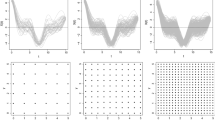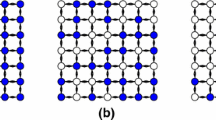Abstract
It is well known that the autocorrelations among responses play a significant role in time series setup mainly for the purpose of forecasting. Similarly, in a spatial setup, spatial variation and correlations among responses collected from a large sequence of spatial locations are important parameters for any practical inferences. For example, variation in plant crop damages and correlations among neighboring plant crop damages are important parameters to understand before one can take suitable measure to prevent such damages in the future. In this setup, a group of neighboring plants or locations constitute a family, and the pairwise responses within a family of locations are likely to be correlated. Furthermore, the responses from neighboring families will also be correlated but they become uncorrelated when the locations are far apart. In this paper, we deal with modeling of spatial correlations for continuous data collected from non-linear sequence of locations and propose a pairwise linear mixed models-based moving or band correlation structure that reflects the correlations for within and between families. The proposed correlation structure is then exploited to develop the likelihood inferences for both variance and correlation parameters of the model. The regression parameters are also estimated. The correlation model and the inferences are illustrated using a monte carlo study for a simpler case with responses collected from a linear sequence of locations. The correlation mis-specification effects are also discussed.
Similar content being viewed by others
References
Basu, S. and Reinsel, G. C. (1993). Properties of the spatial unilateral first order ARMA model. Advance in Applied Probability 25, 631–648.
Basu, S. and Reinsel, G. C. (1994). Regression models with spatially correlated errors. Journal of the American Statistical Association 89, 88–99.
Berger, J. O., Oliveria, V. D. and Sansó, B. (2001). Objective Bayesian analysis of spatially correlated data. Journal of the American Statistical Association 96, 1361–1374.
Cressie, N. (1991). Statistics for Spatial Data. Wiley, New York.
Cressie, N. (1993). Statistics for Spatial Data. Revised edition. Wiley, New York.
Cressie N. and Johannesson G. (2008). Fixed rank Kriging for very large spatial data sets. Journal of the Royal Statistical Society, Series B 70, 209–226.
Cressie, N. and Wikle, C. K. (2011). Statistics for Spatial-Temporal Data. Wiley, New York.
Gaetan, C. and Guyon, X. (2010). Spatial Statistics and Modeling. Springer, New York.
Gelfand, A. E., Kim, H-J, Sirmans, C.F. and Banerjee, S. (2003). Spatial modeling with spatially varying coefficient processes. Journal of the American Statistical Association 98, 387–396.
Hansen, L.-P. (1982). Large sample properties of generalized method of moment estimators. Econometrica 50, 1029–1054.
Jones, R. H. and Vecchia, A. V. (1993). Fitting continuous ARMA models to unequally spaced spatial data. Journal of the American Statistical Association 88, 947–954.
Kang, E. L. and Cressie, N. (2011). Bayesian inference for the spatial random effects model. Journal of the American Statistical Association 106, 972–983.
Kang, E. L., Cressie, N. and Shi, T. (2010). Using temporal variability to improve spatial mapping with application to satellite data. The Canadian Journal of Statistics, Special issue, Ed. B. Sutradhar 38, 271–289.
Prabhakar Rao, R., Sutradhar, B. C. and Pandit, V. N. (2012). GMM versus GQL inferences in semi-parametric linear dynamic mixed models. Brazilian Journal of Probability and Statistics 26, 167–177.
Sutradhar, B. C. (2011). Dynamic Mixed Models for Familial Longitudinal Data. Springer, New York.
Vecchia, A. V. (1988). Estimation and model identification for continuous spatial process. Journal of the Royal Statistical Society, Sec B 50, 2, 297–312.
Vecchia, A. V. (1992). A new method of prediction for spatial regression models with correlated errors. Journal of the Royal Statistical Society, Sec B 54, 813–830.
Author information
Authors and Affiliations
Corresponding author
Rights and permissions
About this article
Cite this article
Mariathas, H.H., Sutradhar, B.C. Variable Family Size Based Spatial Moving Correlations Model. Sankhya B 78, 1–38 (2016). https://doi.org/10.1007/s13571-015-0104-4
Received:
Accepted:
Published:
Issue Date:
DOI: https://doi.org/10.1007/s13571-015-0104-4
Keywords and phrases.
- Family of random effects
- Generalized least square and likelihood estimation
- Linear and non-linear spatial responses
- Moving correlations band
- Pair-wise spatial correlations
- Regression function
- Variable family size.




